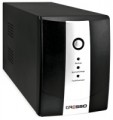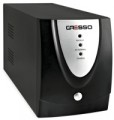—
Standby. The simplest type of UPS, familiar to most ordinary users. Its main purpose is the ability to “softly” shut down work in case of power problems. When the voltage level is normal, the UPS supplies power to the load from the mains, and when the voltage drops or fails, it switches to its own battery. The resource of this battery is usually small — on the order of several minutes, which is usually enough only to save data. Also, such UPSs can smooth out short-term power surges, however, if such surges occur constantly, this wears out the battery and adversely affects the source itself. Redundant UPSs are widely used in home and office environments, they are usually of low power.
—
Smart. A kind of development of the idea of backup UPS; such sources not only provide power in case of a decrease or loss of voltage in the network — they also play the role of voltage stabilizers. The design of such UPSs includes a special regulator (usually in the form of a transformer) that compensates for changes in input voltage and supplies a stable voltage to the output. This allows you to supply constant voltage to the load without the use of batteries, making such blocks well suited for operation in networks with unstable voltage — they not only protect the load, but also do not wear out themselves. Interactive UPSs also mostly have low power and battery capacity and are used to protect individual devices.<
...br>
— Inverter (online). Another name is "double conversion". The most advanced type of UPS providing the highest degree of protection. The name comes from the inverter — an output voltage generator that directly supplies power to the load. The inverter itself simultaneously receives power from two sources — from the network and from a charged battery. In the event of a critical decrease or loss of voltage in the network, the inverter continues to supply energy, only from the battery. Such a scheme avoids voltage surges when switching from the mains to the battery (which is a serious drawback of the two types of UPS described above and can even damage the especially sensitive electronics connected to them). Inverter UPSs have the highest power (up to the ability to power an entire building) and can be designed for a three-phase connection (see "Input voltage"), and some models allow you to select batteries of different capacities, depending on specific needs. On the other hand, inverter UPSs are not very efficient, noisy and expensive, so they are mainly used when high power or advanced protection is critical.
— Low voltage. Miniature UPS for low-voltage electronics backup. Mini devices provide a low voltage DC output (typically 9V, 12V, 15V, or 18V). Traditional sockets are not provided for in their design, and you can usually connect one consumer to them. For example, when there is a power outage from a backup mini-UPS, a short-term autonomous power supply is established for the router (for up to one hour), security systems.Many modern UPSs can be connected to a computer or other special devices. This provides advanced options for monitoring the parameters of the UPS and managing its functions: without leaving the computer, you can monitor the battery status, network parameters, load, enable special modes, apply automatic adjustment, etc. Such a connection can be made according to the following standards:
—
RS-232. It's a COM port. Initially designed to connect various peripherals to a computer. Today it is also quite widespread, however, due to its relatively large size, it is installed mainly on stationary PCs.
—
USB. A universal port for connecting various peripherals to a computer, the most popular interface of this kind today — at least one USB port has an absolute majority of computers and laptops.
-LAN. A port used to connect to wired computer networks. Models with this interface can often be connected as a network device, which allows, if necessary, to control them from any computer on this network.
—
SmartSlot. A slot in the UPS case for installing expansion cards (SmartSlot cards). The development of APC, is used mainly in the devices of its production. Such cards can provide a very diverse set of features: additional connection ports beyond the standard ones (for example, a LAN control port), a web managemen
...t interface, support for SNMP, Secure HTTP and other protocols, connection of temperature / humidity sensors, and much more. To date, a wide range of cards is being produced, making it easy to choose a set of additional functions depending on the specific situation. Most UPS models have one SmartSlot, but if necessary, you can use a special expander and install two cards, and the largest models can have two slots as standard.
— "Dry contact". In uninterruptible power supplies, the term "dry contact" refers to a professional interface used to transfer data on the operation of the UPS to specialized external equipment. Such an interface usually has a whole set of contacts (on the order of 10), often in the form of terminals. And the scheme of its operation can be simply described as follows: when certain parameters are reached, the control relay closes or opens a given set of “dry contacts”, on the basis of which the control device receives information about one or another parameter of the UPS operation.
